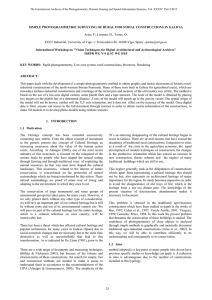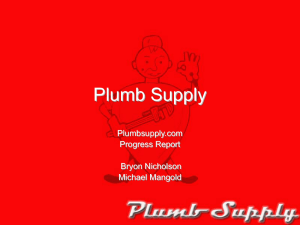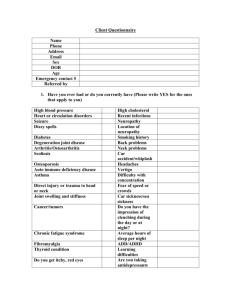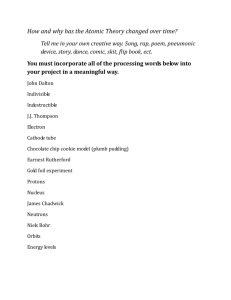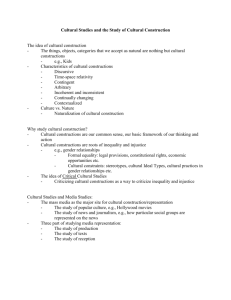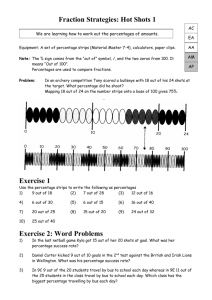SIMPLE METHODS FOR CLOSE RANGE PHOTOGRAMMETRY SURVEYING OF RURAL INDUSTRIAL CONSTRUCTIONS
advertisement
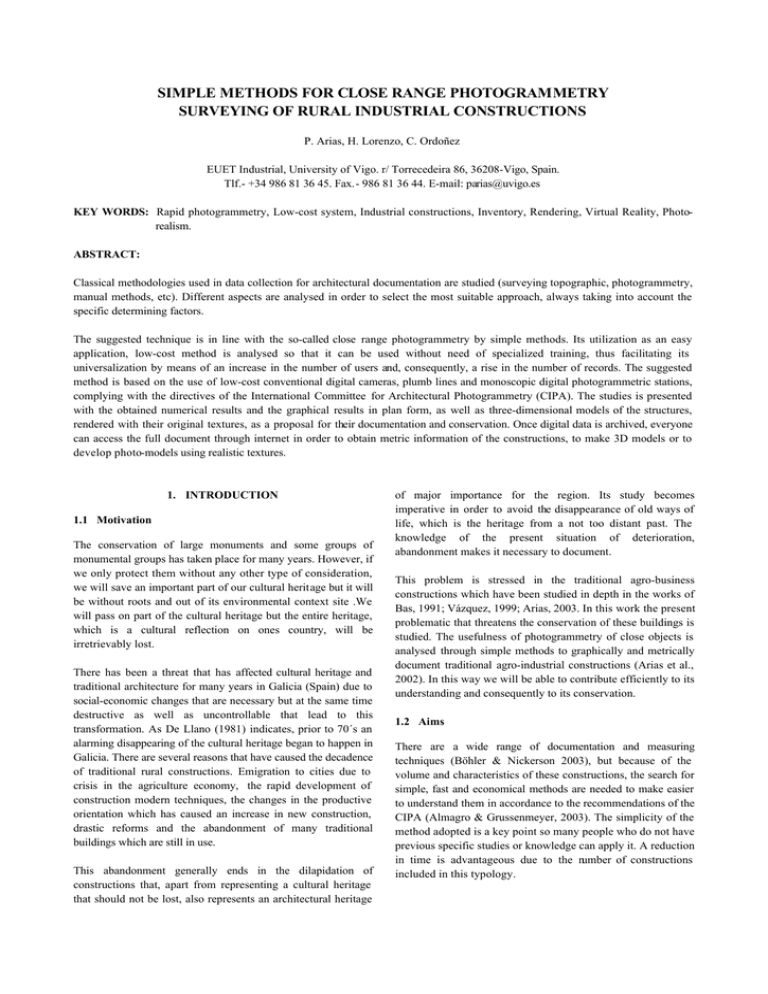
SIMPLE METHODS FOR CLOSE RANGE PHOTOGRAMMETRY SURVEYING OF RURAL INDUSTRIAL CONSTRUCTIONS P. Arias, H. Lorenzo, C. Ordoñez EUET Industrial, University of Vigo. r/ Torrecedeira 86, 36208-Vigo, Spain. Tlf.- +34 986 81 36 45. Fax.- 986 81 36 44. E-mail: parias@uvigo.es KEY WORDS: Rapid photogrammetry, Low-cost system, Industrial constructions, Inventory, Rendering, Virtual Reality, Photorealism. ABSTRACT: Classical methodologies used in data collection for architectural documentation are studied (surveying topographic, photogrammetry, manual methods, etc). Different aspects are analysed in order to select the most suitable approach, always taking into account the specific determining factors. The suggested technique is in line with the so-called close range photogrammetry by simple methods. Its utilization as an easy application, low-cost method is analysed so that it can be used without need of specialized training, thus facilitating its universalization by means of an increase in the number of users and, consequently, a rise in the number of records. The suggested method is based on the use of low-cost conventional digital cameras, plumb lines and monoscopic digital photogrammetric stations, complying with the directives of the International Committee for Architectural Photogrammetry (CIPA). The studies is presented with the obtained numerical results and the graphical results in plan form, as well as three-dimensional models of the structures, rendered with their original textures, as a proposal for their documentation and conservation. Once digital data is archived, everyone can access the full document through internet in order to obtain metric information of the constructions, to make 3D models or to develop photo-models using realistic textures. 1. INTRODUCTION 1.1 Motivation The conservation of large monuments and some groups of monumental groups has taken place for many years. However, if we only protect them without any other type of consideration, we will save an important part of our cultural heritage but it will be without roots and out of its environmental context site .We will pass on part of the cultural heritage but the entire heritage, which is a cultural reflection on ones country, will be irretrievably lost. There has been a threat that has affected cultural heritage and traditional architecture for many years in Galicia (Spain) due to social-economic changes that are necessary but at the same time destructive as well as uncontrollable that lead to this transformation. As De Llano (1981) indicates, prior to 70´s an alarming disappearing of the cultural heritage began to happen in Galicia. There are several reasons that have caused the decadence of traditional rural constructions. Emigration to cities due to crisis in the agriculture economy, the rapid development of construction modern techniques, the changes in the productive orientation which has caused an increase in new construction, drastic reforms and the abandonment of many traditional buildings which are still in use. This abandonment generally ends in the dilapidation of constructions that, apart from representing a cultural heritage that should not be lost, also represents an architectural heritage of major importance for the region. Its study becomes imperative in order to avoid the disappearance of old ways of life, which is the heritage from a not too distant past. The knowledge of the present situation of deterioration, abandonment makes it necessary to document. This problem is stressed in the traditional agro-business constructions which have been studied in depth in the works of Bas, 1991; Vázquez, 1999; Arias, 2003. In this work the present problematic that threatens the conservation of these buildings is studied. The usefulness of photogrammetry of close objects is analysed through simple methods to graphically and metrically document traditional agro-industrial constructions (Arias et al., 2002). In this way we will be able to contribute efficiently to its understanding and consequently to its conservation. 1.2 Aims There are a wide range of documentation and measuring techniques (Böhler & Nickerson 2003), but because of the volume and characteristics of these constructions, the search for simple, fast and economical methods are needed to make easier to understand them in accordance to the recommendations of the CIPA (Almagro & Grussenmeyer, 2003). The simplicity of the method adopted is a key point so many people who do not have previous specific studies or knowledge can apply it. A reduction in time is advantageous due to the number of constructions included in this typology. Improving this situation is a task that concerns society. From this work a method is proposed to palliate one part of this problem, the initial stage of studying and knowledge, which is necessary for a later approach to ideas, solutions or actions. Therefore the aims pursued are as follows: ?? To foment the analysis of the main traditional agroindustrial constructions in Galicia, that are mainly characterised for their simplicity and rusticity. ?? To contribute to reduce the loss of cultural heritage that has been occurring for years, providing tools for its study and knowledge. ?? To obtain a simple methodology in order to apply the technique(s) with a minimum amount of equipment, that is cheap and readily available. ?? To increase the information collected (2D and/or 3D plans, textured models, animations, etc.)in order to facilitate the decision making in later actions. Through the documentation, the information about the condition of the construction at the moment of the shot is collected, allowing a vast knowledge of its condition. In this way, the diverse aspects of the constructions can be analysed, such as techniques and styles of construction, materials used, conservation condition, pathological processes, visible damages location, structural organisation analysis, damage and structural problems detection, and obtaining the real geometry of the construction components. This information conveniently analysed will be able to be used as the base for the actions carried out such as, ethnographic or historical studies, typological classifications, actions of reconstruction or restoration, the buildings reuse, or structures and/or buildings relocation. 2. INSTRUMENTATION AND METHODS 2.1 Instrumentation In the designed method proposed, one of the objectives pursued was the minimal dependence on complex equipment and material which is difficult and expensive to acquire. Therefore the equipment needed will be the following: ?? Plumb lines. These can be made using coloured cord between 2mm and 10 mm thick (depending on the size of the structure and the distances measured) which can easily be seen. Another fundamental point will be the weight of the plumb bob itself which lends to the vertical position of the cord. Anything of sufficient weight can be used (usually a stone or something similar found at the site). ?? Tape measure. A retractable tape measure will be necessary (one of 5 meters should suffice). This will be used to measure the distances between the marks previously made on the plumb lines. ?? Digital cameras. Cheap conventional digital cameras and a CCD as a sensor element to take the photographic shots. The precision will improve by increasing the resolution of the cameras used. Moreover, a camera preferably without a zoom and with sufficient internal stability that allows the determination of its aberrations is preferred. ?? Tripods. The photographic shots must be taken based on the fundamentals of both photography and photogrammetry, therefore it is recommended that a camera tripod be used for stability.. ?? Digital monoscopic photogrametric systems. Due to the characteristics and objectives pursued in this work, the use of these systems will be recommended. Its main characteristic will be adaptability making it possible for anyone without prior training to use on any type of computer. These photographic systems are perfectly integrated with conventional CAD systems, making its use extremely easy in a wide variety of areas and applications. 2.2 Methods The method developed is organised in sequential and clearly different phases following the rules 3?3 (Waldhäusl & Ogleby, 1994); in the first one, called field work phase, photographic shots of the chosen construction will be taken, and enough information for its subsequent orientation and scale will be collected. In the second one, known as laboratory work phase, all the information collected in the field work phase will be processed to obtain plans and three dimensional models from the chosen construction. 2.1.1. Field Work: It consists of the acquisition of the necessary data to be able to carry out the later works. In this phase will be possible to be distinguished the following processes: ?? Previous definition of pursued objectives. Before starting any documentation work it is necessary to define clearly and precisely the pursued aims, the ambit and the importance of the action (type of construction that is interesting to document and which elements are interesting to know).Objectives that are not very precise will directly affect the laboratory work and consequently the quality of the final results. ?? Positioning and measuring of plumb lines. They are used for the levelling, scaled and geometric definition of the fotogrametric models.. The plump line direction will determine the direction of the x axis. It will be necessary to establish a series of marks on the plumb lines which can be perfectly identified in the photographs. The distance between marks, which form the scale and geometrically define the models, must be measured accurately. ?? Carrying out photographic shots. In order to do this, cheap conventional digital cameras with CCD as image sensor element are recommended. Photographic shots will be made taking into account aspects like the search of the suitable illumination of the photographed object, avoiding shades, reflections, burned photos, etc; it is recommended to use the camera on a photographic tripod to avoid moved photos, or in its defect to make the shots with the camera supported on some stable element; it will be preferable to make the shots with elevated values of depth of field, because we will not run the risk of defocusings; each element to represent must be content in a minimum of three photograms; the convergence between photograms taken from different positions must have optimal values of 90º and good values of 60º, so that the adjustment of beams is made in good conditions; whenever it is possible, a perpendicular shot to the face of the object to photograph will be made; the overlaps between photograms will have to be of 50% at least; the shots will have to be made of such form that the element covers most of the photogram surface. In Figure 1, two examples of photographic shots are shown; a general shot and a detailed shot. In the right image, z axis direction defined by the plumb line is indicated. process it, or it can be immediately processed, resulting in 3D models of the original structure. In order to reach this objective it will be necessary to resort to the photogrammetric stations. Due to the characteristics and aims of this work, the use of Digital Monoscopic Photogrametric Systems are recommended. A series of successive steps will be carried out when processing this data, as is briefly stated below: ?? Orientation of the Photograms. In this process the position of the shots is calculated. In Figure 2, you can see different positions of the photographic shots we have made. ?? Levelling and forming the scale of the model. From the direction defined by the plumb lines, z axis is established and so the model will be levelled. The scale is attained from the distances measured on the plumb lines. ?? Restoring of points, lines, polylines or other interesting graphic sources, thus obtaining numerical values, measurement and 2D and/or 3D models (wire models, surfaces models, textures models, etc). ?? The three-dimensional models generated are now able to be exported into conventional formats (dxf, dxb, vrml, etc.)or to other programs for their display and/or processing treatment. Figure 2. Positions of the different photographic shots calculated in the orientation process . 3. RESULTS Plumb line Figure 1. Example of the photographic shots. In the second image, z axis direction defined by the plumb line can be seen 2.1.2. Laboratory work: Once field work has been finalised, laboratory work begins, proceeding with the analysis and processing of the information collected. With this information saved and classified two different alternatives are considered: the information can either be filed away until the need arises to 3.1 Numerical results In table 1 the theoretic results obtained can be seen when the process of orientation was carried out on a “Photomodeler Pro 4.0”digital photogrametric station. The shots were taken with a “Kodak Dx3500” digital camera, exclusively using plumb lines on which the distances were previously marked for the orientation, scale and to obtain the model geometry. The results viewed provide information on the quality of the process of orientation and indicate: an average of 95% of the accuracy of the points and the quadratic composition of the averages; the average quadratic error, the average error and the maximum error in metres observed in the parallax; standard deviation in pixels and maximum value of the residues observed for one point. Accuracy at 95% (m) X Y Z Average 0,001 Quadratic comp. 0,017 Parallax (m) 0,005 RMS (píxel) Max. residue (píxeles) 0,612 0,018 Av. quadratic error Average error 0,008 Maximun error 0,022 0,007 2,150 Table 1. Results obtained processing the data with a digital photogrametric station “Photomodeler Pro 4.0” 3.2 Graphical results The graphical results are shown by the flat representation of the restored model and the projections of the three-dimensional models with photorealistic textures. In Figure 3, an elevation and a profile obtained from threedimensional points model , lines and polylines are shown, which are restored on the digital photogrametric station “Photomodeler Pro 4.0”. Later, the three-dimensional models were transferred and processed on CAD software. Figure 3. Elevation and profile of the studied structure. Different renderings of photo-realistic textures have been obtained from the three-dimensional surface model, such as those seen in Figure 4. These textures have been applied from photographic shots of the object itself. Figure 4. Rendering with photo-realistic textures 4. CONCLUSIONS The precision obtained in the process of generating threedimensional models, correspond perfectly with those expected when applying simple photogrammetry principles of close objects. The values and obtained precisions are agreed with the demands of precision that are considered necessary between 2 and 5 cm (Scherer, 2002). In regard to field work, it is highly important to make a good initial planning because this will reduce the total amount of time needed to optimize the results. A sketch of the object, the position of both the plumb lines and the camera as well as the field covered by each shot is fundamental in order to facilitate later classification and processing work of the information collected during this phase. A fundamental part of the work which will determine the final results quality will be the photographic shots taken and the principles of photography and photogrammetry followed. The use of digital cameras is considered ideal in situations in which there is a limited budget to purchase equipment and when the obtaining of high precisions is not essential. Furthermore, this type of camera suitable because the cost of developing the photos is practically null. Therefore it is recommended to take many shots (from different positions and view points), a factor which will directly influence the degree of precision reached. The use of digital monoscopic systems are recommended, also denominated digital monoscopic photogrametric systems, to process both data and also to obtain 3D models of the studied structures. The fundamental motives will be due to the reduced cost of the above (approximately 1200 €), as long as the purchase of vision stereoscopic systems is not necessary. However if necessary and due to its versatility , it will not present many requirements of the system and can be installed in practically any type of computer (laptop or PC). Operators do not require lengths processes of learning nor previous training as it happens with the stereoscopic systems . 5. REFERENCES ALMAGRO, A. 2003. Programa de presentación. XI Jornadas de restauración del Patrimonio. Paisajes Culturales. Fundación Santa María de Albarracín. Albarracín (Teruel). España. 20-22 Marzo. ALMAGRO, A.; GRUSSENMEYER, P. CIPA Working Group 3. Simple methods for Architectural Photogrammetry. http://cipa.icomos.org/wg3.html ARIAS, P; VÁZQUEZ, S.; LORENZO, H; REGO, T. 2002. Photogrammetric survey in traditional rural constructions in Galicia (Spain). XVIII International Symposium of CIPA. Potsdam (Germany). September, 18-21. Pag.: 188-195 ARIAS, P. 2003. Fotogrametría de objeto cercano por métodos simples. Aplicación al estudio de las construcciones agroindustriales tradicionales. PhD Thesis, University of Vigo. Pontevedra, España. BÖHLER, W.; NICKERSON, S. 2003. CIPA Working Group 6. Surveying methods for heritage recorders. http://cipa.icomos.org/wg6.html DE LLANO, P. 1981. Arquitectura popular en Galicia (a casavivenda, as serras). Colexio oficial de arquitectos de Galicia. Santiago de Compostela. España. SCHERER, M. 2002. About the synthesis of different methods in surveying. XVIII International Symposium of CIPA. Potsdam (Germany). September, 18-21. Pag.: 423-429. VÁZQUEZ, J.M. 1999. Problemas y perspectivas del patrimonio etnográfico de Galicia. Ed: Forno Novo. Deputación Provincial da Coruña. A Coruña. España. 53 pag. WALDHÄUSL, P. & OGLEBY, C. 1994. 3-by-3 rules for simple photogrammetric documentation of architecture. In: Fryer, J.G. Close range techniques and machine vision. Proceedings of the Symposium of Commission V of ISPRS. Melbourne, Australia. 1-4 March. 6. ACKNOWLEDGEMENTS This work is part of the investigation project APLICACIÓN DAS TÉCNICAS DE FOTOGRAMETRÍA TERRESTRE, RADAR DE RANGO CERCANO E 3D-LASER SCANNING PARA A ANALISE DIMENSIONAL E ESTRUCTURAL DE CONSTRUCCIÓNS DO PATRIMONIO financed by Xunta de Galicia. We would like to especially thank Professor D. José Herráez from the Politechnic University of Valencia for his advice and suggestions on obtaining data and methodology.
